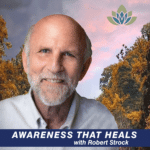 Episode 122
Episode 122
In part three of caring for anxiety, we continue to emphasize being aware of our anxiety, recognizing its presence, and responding with compassion. This practice is a subtle but vital skill that supports us as we care for ourselves. By being mindful of our thoughts, especially in the context of anxiety, we can observe whether these thoughts are supportive or critical, allowing us to shift toward more caring and welcoming thoughts.
This approach helps us develop a deeper connection with our anxiety, viewing it as a part of ourselves that needs care. The practice of welcoming anxiety, rather than resisting or denying it, can be a powerful tool for personal growth and emotional well-being. The goal is to cultivate a mindset that supports self-care and acceptance, ultimately helping us manage our challenging emotions more effectively.
Resources related to this episode
• Robert Strock Website
• Podcast Episode Video (YouTube)
• Robert’s Book, “Awareness that Heals”
• The Introspective Guides (Free Download)
Note: Below, you’ll find timecodes for specific sections of the podcast. To get the most value out of the podcast, I encourage you to listen to the complete episode. However, there are times when you want to skip ahead or repeat a particular section. By clicking on the timecode, you’ll be able to jump to that specific section of the podcast. Please excuse any typos or grammatical errors. For an exact quote or comment, please contact us.
Transcript
A very warm welcome to season three of Awareness That Heals where we have progressed to be able to focus on one challenging emotion at a time. This will allow you to choose a specific emotion that you’ve had challenges with, and each one will have a progressive series of guided meditations that will allow you to go deeper and deeper into self-compassion. For me, it’s truly inspiring because each emotion has unique nuances for both self-care and responding to your environment at the same time. This is subtle and a rare skill as all too often we don’t stay aware of how we can care for ourselves as we are. I hope that you’ll not only find it helpful, but also give you deep resources that you can internalize when the emotion is most emerging as possible. Be aware of your anxiety right now. Now notice the words are as gently as possible, which means that you’ll naturally breathe in a rhythm that’s as easy as possible for you. And say, anxiety, I see you. And recognize that this seeing of your anxiety while it’s happening is somewhat miraculous because it gives you the capacity. This seeing gives you the real possibility of being responsive in a way that’s going to care for yourself. It’s going to give you the possibility of actually welcoming the anxiety instead of resisting it or denying it.
Remember, every thought matters, and especially awareness or being aware of this thought matters because when you see the thoughts that come right after your anxiety, you can see if it’s leading you in the direction that’s going to support you or it’s going to bring you down. Are you helpfully focused right now or critical? Just look, be honest. And if you’re critical, let yourself move and recognize. Of course, I want to be caring and welcoming. Now, look deep in your heart and find a place at least in your thoughts. If can’t reach it emotionally that wants to care, it’s totally crucial that you’re aware of your anxiety and sending caring at the same time. And I keep repeating that because when you catch it right as it’s happening, that’s what allows the magic to occur. Letting yourself feel again and again, the acceptance and the anxiety together. And now we can move it to even another level, which is, as you’ve learned how to care for yourself more or starting to care for yourself at least in thoughts, and you’re more and more tolerant and accepting, there’s actually a sense of welcoming anxiety,
Welcoming anxiety as if it’s your friend because it is your friend. Of course, you’re not anxious on purpose, but your anxiety is a part of you that is asking for caring. And also you can recognize that it isn’t. You are the awareness that is able to see the anxiety and allow yourself to be capable of responding in so many ways that we’re going to keep exploring. So see where you are right now. Are you caring for yourself? Are your thoughts supportive? And if they aren’t, see if you can shift them because you know can’t automatically have a wand and change the feelings of anxiety. But you definitely can change the thoughts about the anxiety. Anxiety. I see you again and again. You’re recognizing that your capacity to be this awareness and seeing it is the key first step.
And now as you see it, let yourself find a place that’s able to say, I welcome you into my life now and ongoing because I recognize you’re a part of me, whether I try to resist you or not, or I suppress you or not. And if I can have a direct relationship with you while you’re here, that allows me to welcome you. It also allows me to develop other capacities that are more and more supportive. And if you can’t emotionally welcome yourself, you can find the mind, your mind, your intelligence, your wisdom that at least in thought is going to be on your side. What do you have to lose? And as you end this meditation, just see naturally without judging, what’s the vibe? What’s the tone? Are you able to guide yourself with your thoughts only? And if so great, or are you actually able to tolerate? Are you able to accept? Are you able to welcome and wherever you are? Hopefully, appreciate yourself for moving more and more in this direction to care for welcome and to discover how you can best care for your anxiety.

Join The Conversation
Thanks for listening to Awareness That Heals. Please click subscribe, so you won’t miss an episode. If you love the podcast, the best way to help spread the word is to rate and review the show. This helps other listeners, like you, find this podcast. We’re deeply grateful you’re here and that we have found each other. We encourage you to download our Introspective Guides at awarenessthatheals.org; they will be helpful to you while listening to our podcast.
Visit our podcast archive page

